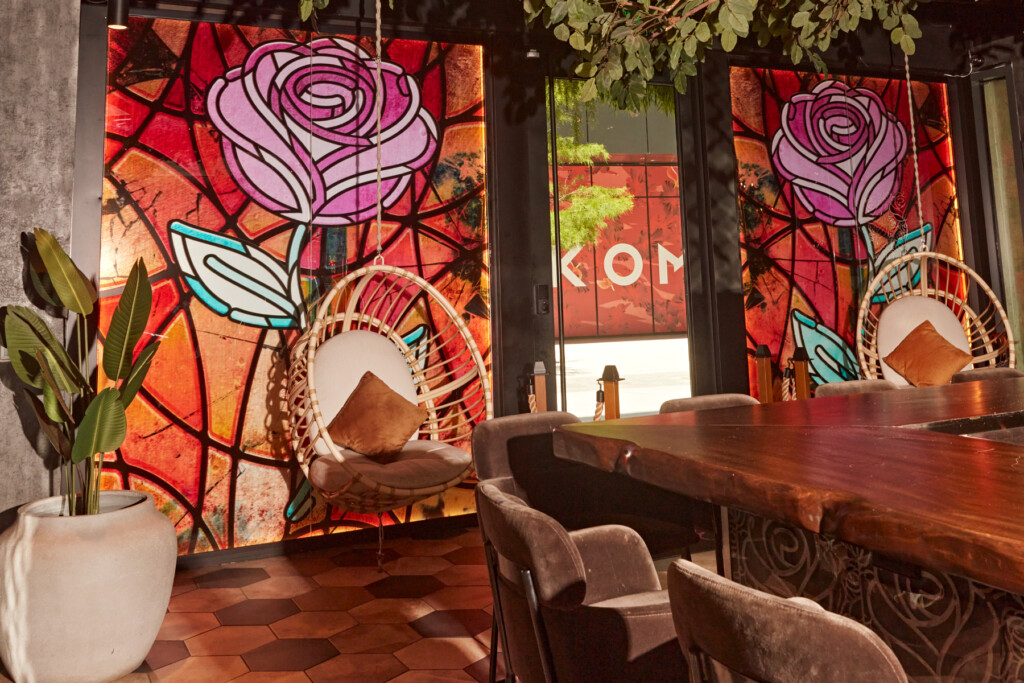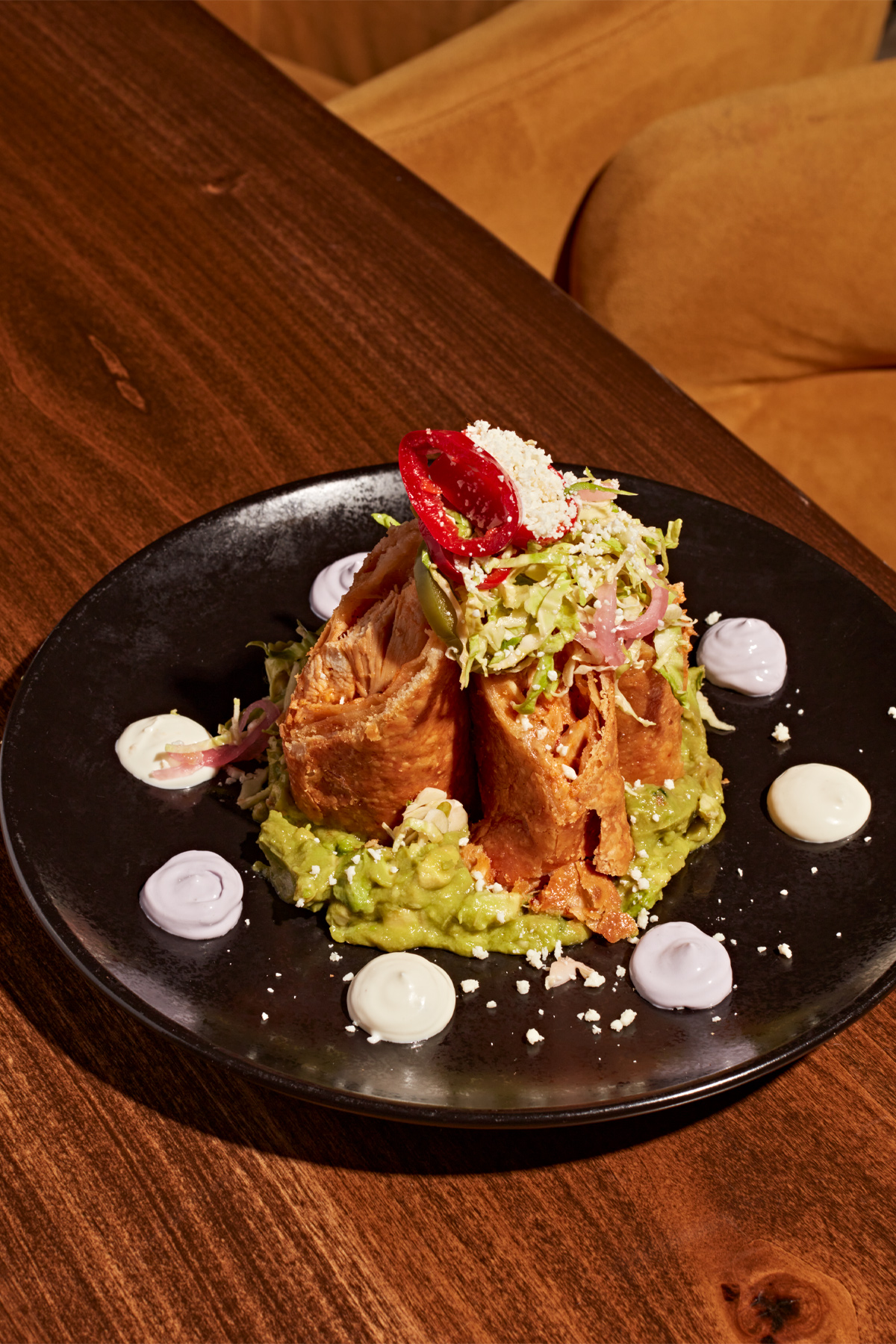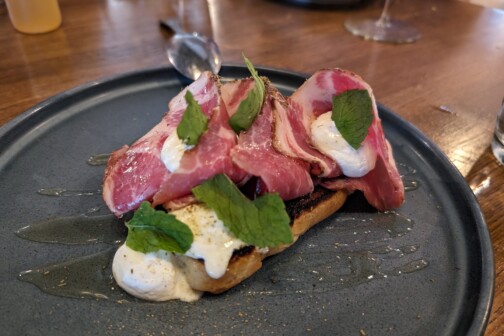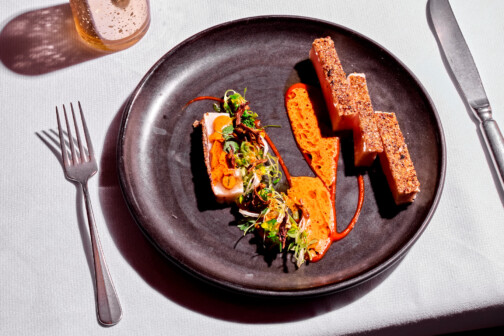A tall tree with beautiful green leaves stands at one end of a newly built Deep Ellum alley. The tree is fake. The trunk is aluminum and steel; the leaves are polyester. Down the center of this alley runs a water feature. At each end, two long legal notices are permanently chiseled into the pavement. If a child ever decides to splash in this fountain, she’ll have to step over a six-point list of warnings.
“Use of the water feature when ill with diarrhea is prohibited,” reads the engraving etched into the sidewalk in front of three of Dallas’ most stylish restaurants.
This is The Epic, a massive 8-acre development from real estate investment firm Westdale that means to transform the far western end of Deep Ellum while keeping its back turned to the neighborhood.
To access the area containing the fake tree and excretory warnings, you must almost deliberately get lost, walking from Elm Street past The Epic’s historic Kimpton Pittman Hotel into a corridor loaded with loud ventilation ducts, caged electrical boxes, and parking garage exits. Hidden inside this hostile fortress is a trio of shiny restaurants housed in two new high rises: La Neta, a Mexican-ish chain from Las Vegas; Komodo, an Asian fusion chain from Miami with celebrity admirers; and Harper’s, a Dallas-based steakhouse that opened in 2021 and set the tone for the rest of the street.
As Deep Ellum celebrates its 150th anniversary, debates rage in the media about its safety, its crowds, and its future. The Epic proposes an alternative to the area’s rebellious streak and working-class edge: a luxury playground of swanky, clubby restaurants. Places where you can dress up, eat Peking duck salad or whole lobster in a taco, and catch celebrities touting their liquor brands.
If these three restaurants represent Westdale’s vision for the future of Deep Ellum’s food and drink scene, what can the neighborhood expect? We visited each of them to find out.
La Neta
The name “La Neta” is Mexican slang for “the truth.” So here’s the truth: when my waiter brought out an order of flautas and I asked why some dots of sauce were white but others were a vivid lavender, he said, “It’s the same sauce. They add food coloring.”
That’s La Neta in a nutshell. The ceiling bristles with green plants (fake). Around semicircular booths, the designers have added more jungle-like ferns and grasses (fake). The front doors are framed by what appear to be stained-glass windows (they’re plate glass with a printed-on design—so, fake).
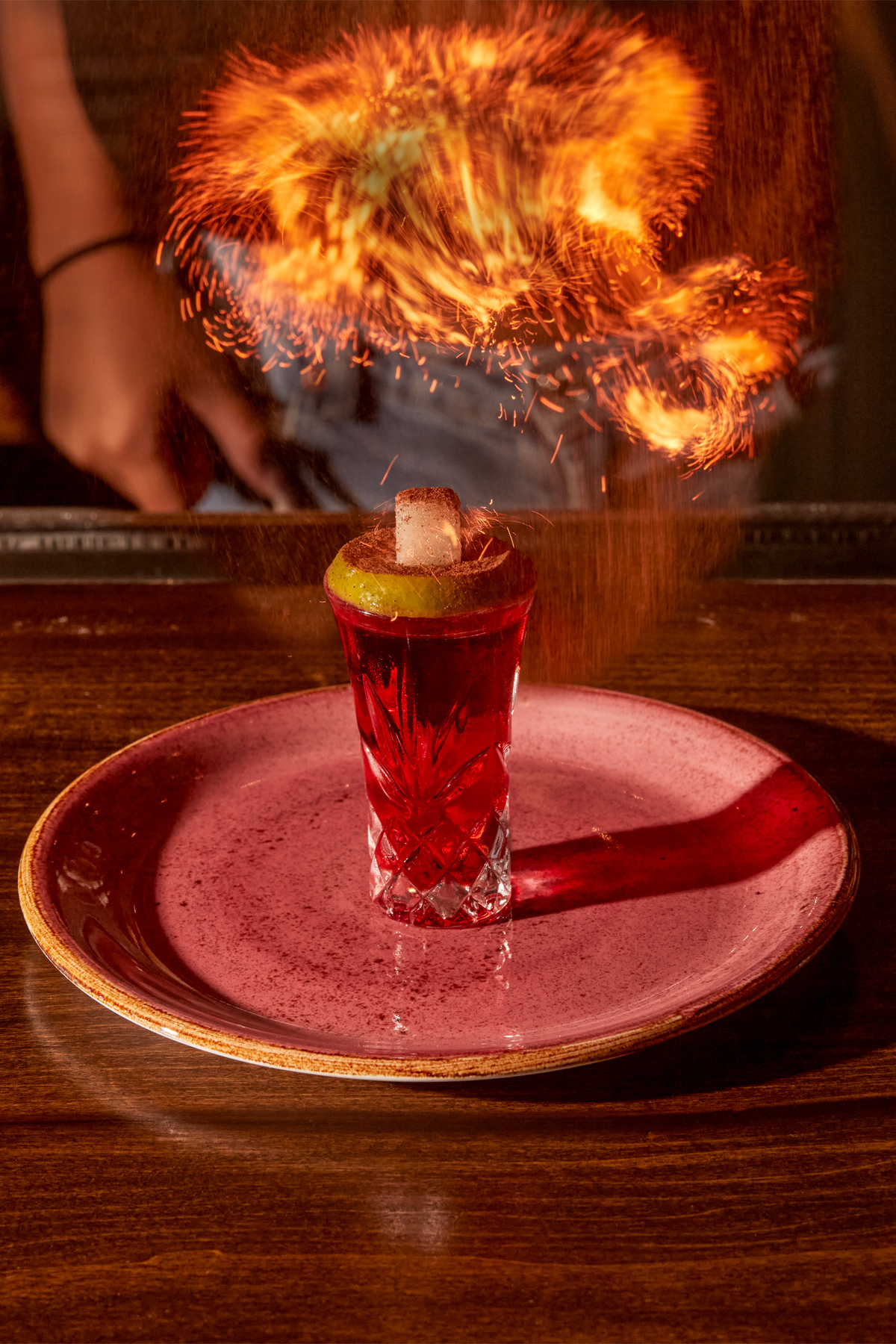
With so much unabashed inauthenticity, to describe La Neta’s menu as “fake Mexican” would be redundant. “Fake food” is more apt. Those flautas, in size and texture more like egg rolls, sit on a bed of guacamole. I dragged the flautas aside and saw that the guacamole had turned brown. A month later, we ordered “tuna tartar” and found it sitting on more camo-patterned guac.
Every dish here is askew. Albondigas, Mexican stewed meatballs in tomato sauce, come with cheese-covered slices of bread. Wouldn’t tortillas be better? The kitchen drapes an enormous brown sheet of crisp molten cheese over the top of the quesadillas. It’s a fun idea, but the cheese blanket makes portioning hard and coats everything under it in grease. Wedge salad has a rounded dome top with croutons on the side because when your salad is round everything falls off.
One of La Neta’s showpieces is its “BIG F*#K’N TACO” featuring “whole lobster,” slaw, and a cheese-stuffed tortilla for $95. We wondered, do they put a whole lobster on top of a tortilla?
In fact, they do the opposite. After carving meat from the back of a lobster, the kitchen turns the poor creature into a taco holder, wedging food onto its back. (Lobster stuffed with tacos is a joke from season 9 of The Simpsons.) Since the taco itself is more than a foot long, one lobster torso makes an ungenerous portion of meat. The rest is filled with cheap veggie slaw. As for the tortilla, it’s cooked until it’s as dry as a gigantic cracker.
“Strip steak birria,” served with jalapeño hash and birria consommé, arrived in an enormous cast-iron skillet. Our waiter added some kind of sauce and set the whole thing on fire. “The skillet is hot,” he warned. He needn’t have worried: after the fire went out, the skillet wasn’t hot. The steak wasn’t hot, either. The hash was mush.
Regarding the pork chop, I must make a confession. I didn’t mind that 40 percent of the chop’s outside was charred black. I only minded some that the inside, requested medium, was chalky-dry. What I hate, it turns out, is hibiscus rice. This is not La Neta’s fault. The rice is cooked properly and so full of hibiscus that it glows purple. But a fruit smoothie absorbed into rice is not for me. My bad.
What is La Neta doing if it’s not focusing on food? Charging big money for drinks, of course. Margaritas are $20-$23 for pre-made bulk batches poured from taps into heavy, volcano-shaped mugs with no handles. Good luck picking them up. If you want a margarita made especially for you, tailored to your liking, it will be prepared tableside—for $65. (Gold flakes are $5 extra.) We paid a less lavish $16 for the most unpleasantly artificial paloma in Dallas and $14 for an equally bogus ranch water. (Here is how you make a ranch water: open a Topo Chico. Pour some out. Replace it with tequila. Add a lime wedge. Sorry to be a hardliner, but all other recipes are wrong.)
La Neta’s best quality is that it knows it’s stupid. Our servers were consistently honest about the experience we were getting. We especially appreciated their candor when we ordered the shot that gets set on fire.
A fruit smoothie absorbed into rice is not for me. My bad.
The shot is bright red and topped with a slice of lime and a sugar cube. The first sugar cube didn’t fully catch flame. “Sorry, sometimes the Everclear doesn’t soak in all the way,” our server told us, setting the drink down. It tasted so much like watermelon Jolly Ranchers that I giggled. Then our server brought us another one. “I found the good sugar cubes,” he explained, lighting the new one with a steady blue flame. When he threw cinnamon at the drink, it caused sparks to fly and our waiter to lament, “Literally every Saturday night we’re covered in cinnamon.”
A few minutes later, one of my dining companions found a clump of cinnamon in her water. Watching it float around, she completed our evening of truth-telling: “It looks like fish food.”
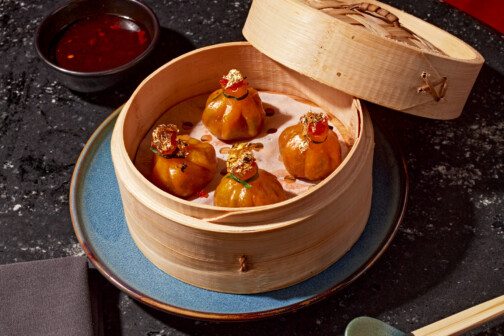
Komodo
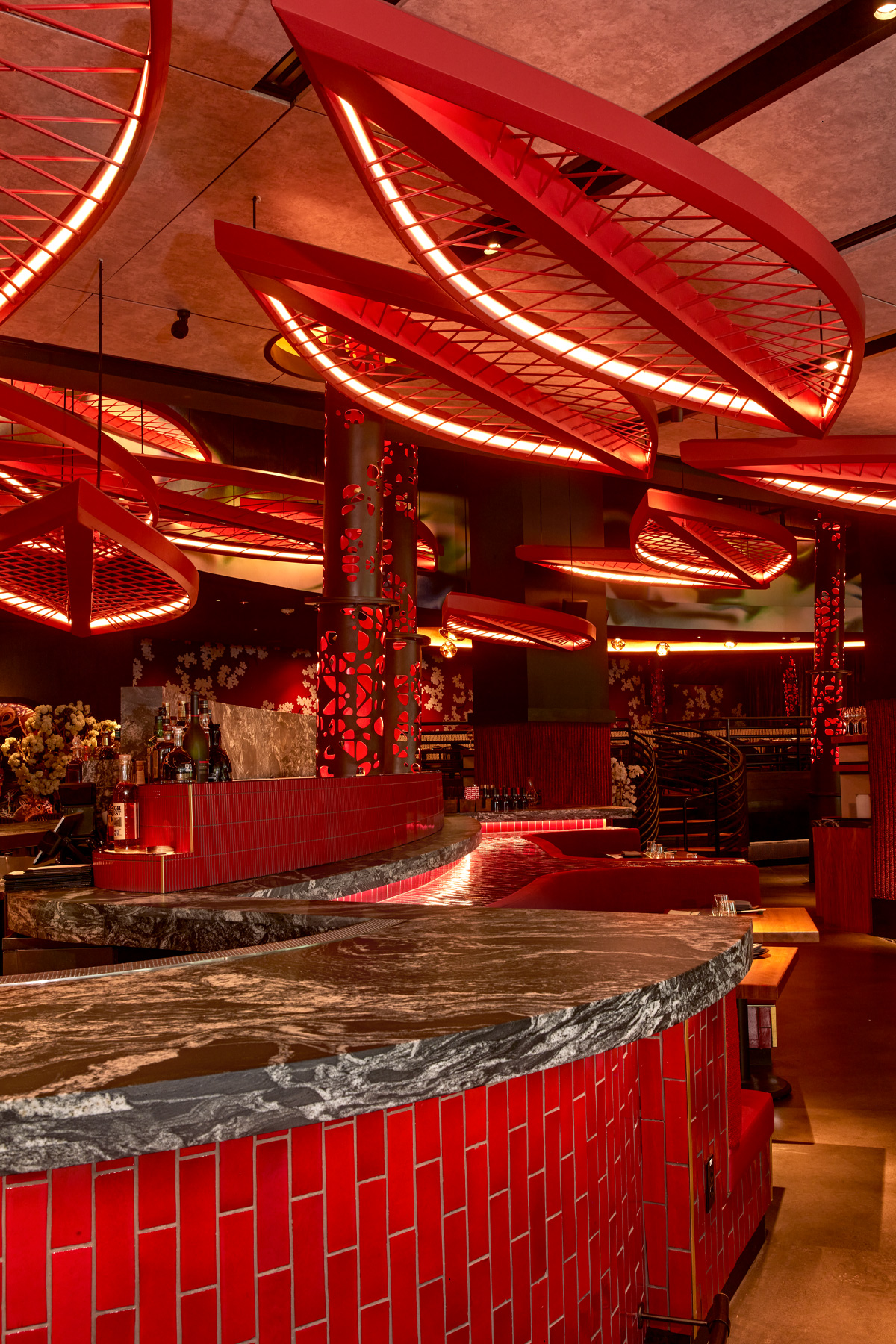
The first time we visited Komodo, we saw three couples making out.
The dining room is not my idea of romantic—it’s huge and open—but it is monumental. A strikingly modern design features warm red light pillars that look like tropical plants, airy wooden leaves, and huge plate-glass windows. After you’re welcomed in by a doorman standing at a velvet rope, you’ll pass the artful wine cellar display, a row of whole Peking ducks hanging in the kitchen window, a lavish bar, and an elevator taking guests to the club level.
This is an exciting dining room. Around our table, girls’-night-out groups exchanged gifts, and at least three diners were served birthday desserts with sparklers. Plus, the canoodling. It’s not just the physical space that gets people excited to visit Komodo. The cocktails are very nice, even when they’re not presented, as one is, in ceramic Pikachu mugs. Service can be excellent, with waiters bringing unexpected fine-dining polish to the party. (Though one asked, “Are you guys cool with sushi?”) The wine list is conservative but splashy, with deep collections of white Burgundy and California cabernet.
Komodo is the perfect place to drink a cocktail from a Pikachu, people-watch, and feel Dallas’ pulse. It’s also a good place to eat—if you follow a very specific plan.
That plan builds up to the restaurant’s signature dish: Peking duck. The duck here is big on flavor, with an edge of barbecue-like smoke and well-rendered fat. It comes with the proper trimmings—incredibly thin pancakes, slices of cucumber and scallion, and sauce—but at $105, Komodo’s duck costs about double what you’d find at a good Chinese restaurant such as Plano’s Bamboo House, which also achieves a crispier skin. Yet if you’re at Komodo with a group, this is the dish to get.
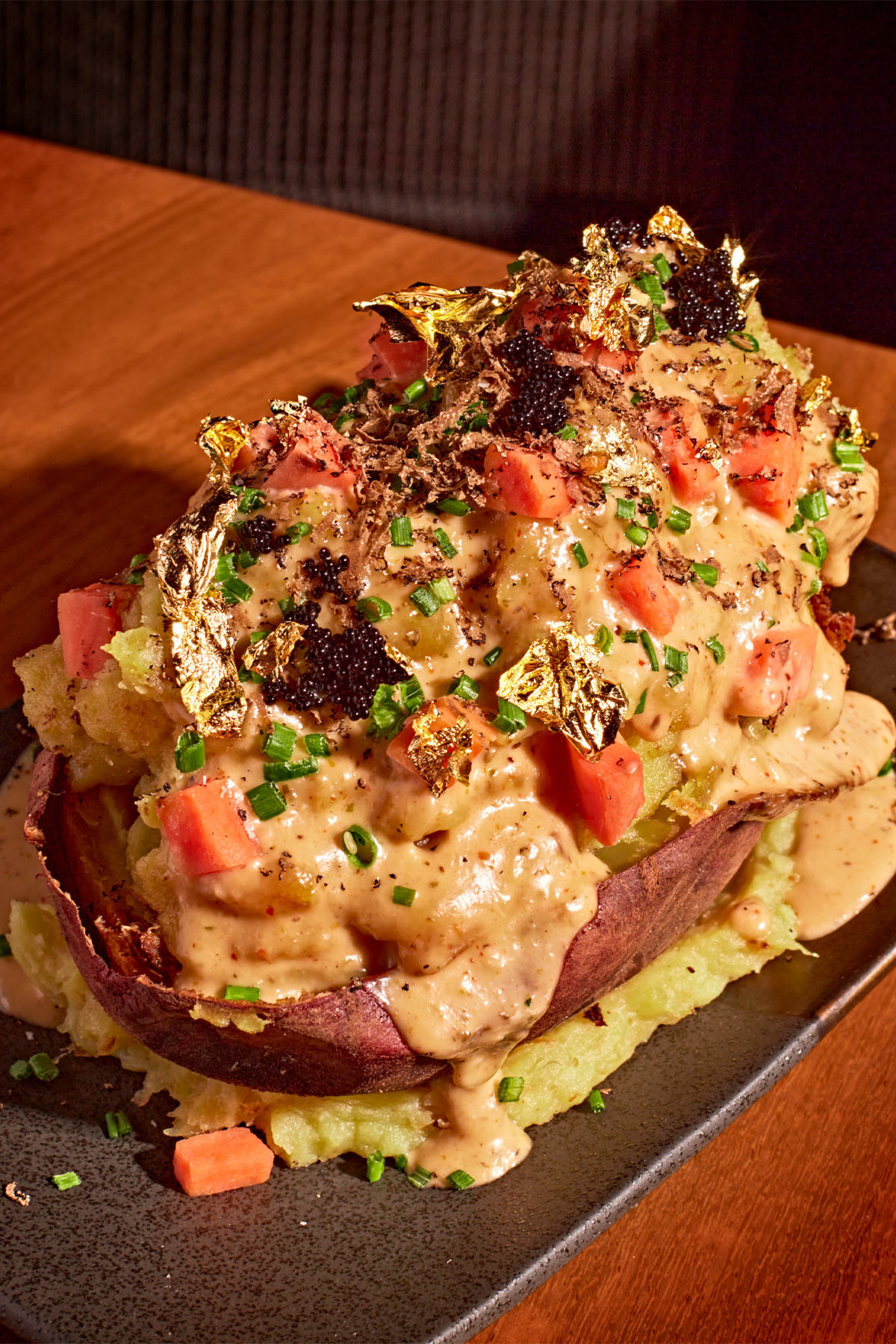
Around the duck, plan to share a select handful of sides. Grilled eggplant teems with crispy garlic chips, and duck trimmings get repurposed into a vibrant salad with lotus root chips and plum vinaigrette. Beef dumplings pack big flavor, even if I suspect that the sauce on the plate is just mayo and orange zest.
Stray from this path, though, and trouble awaits. Many dishes offer the bare minimum of flavor their ingredients can provide. The famous “money bag” dumplings are regular pork and shrimp dumplings, topped with gold leaf so that Komodo can charge $30 for four. Lobster and shrimp shumai dumplings don’t taste like anything at all, because the seafoods are mixed and topped with crab sauce and fish roe. The crab sauce is brown, and tastes brown.
The “super sweet potato,” topped with gold and caviar and sculpted into the shape of a starchy stegosaurus for $28, tastes like mashed sweet potato. Similarly, the pastrami egg rolls (two for $23) are meat in egg rolls. One of my friends quipped, “If I didn’t know the price tag, and we were at Cheesecake Factory, I would love them.”
Our “wokked vegetables” sat in a half-cup of gloopy brown sauce. All the sushi and sashimi here suffers from bad rice—wrong on flavor, texture, and temperature. The avocado slices on my rainbow roll were so stiff that they flipped up like diving boards after someone jumps off. Crab lo mein is advertised as having “Chinese sausage,” but our portion had none. Only one guest in my party of four could detect Szechuan peppercorns on the “Szechuan” New York strip steak.
Komodo has a good chance to stick because its duck anchors an experience that, apart from the food, is stellar. In the process of submitting receipts, however, I discovered that Komodo charged me a 3 percent service fee at the dining table but a 23 percent service fee for a round of cocktails at the bar. My printed bar receipt had yet another tip line, where I unwittingly left a second tip using the “Suggested Tip” math printed underneath. I felt cheated. (A representative for the restaurant says the 3 percent fee goes to “benefits for employees” and the 23 percent charge was a mistake. The restaurant’s bar is meant to charge 3 percent; the larger charge is meant for the lounge level.)
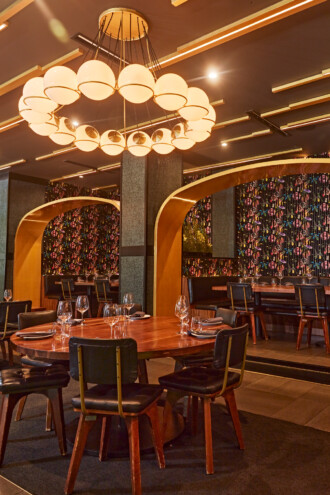
Harper’s
For the clearest vision of the Deep Ellum that Westdale wants to build, head to Harper’s. It’s a decent place to eat, but its hype has faded. What remains is the result of viewing a dining establishment as fashion trend: big today, quiet tomorrow.
Harper’s feels like it’s in a posh hotel, even though it’s not. Peacock wallpaper, slatted wooden walls, an airy bar, colored lighting, and impressive archway-topped booths all contribute to its nice-hotel energy. There’s a glitzy display case of premium liquors, too—in the bathroom hallway, next to the ladies’. No wonder the restaurant’s owners feel they can export the concept, which recently became a chain with the opening of a Nashville location.
But not all is well. When I first walked in, the dining room was so empty that even employees didn’t appear for a few minutes. Since nobody was at the bar, its TVs were playing a slideshow of the restaurant’s own logo being drawn and erased.
Seeing only nine other paying customers at 7 pm, my party braced ourselves for the worst. The menu’s “theme”—of world travel, allowing the kitchen to shoehorn everything from potstickers to rigatoni alla vodka—also boded ill. But that rigatoni is actually pretty good. The noodles have a lovely texture, and the sauce has some spice. Even better, in what might be a Dallas first, “crispy Brussels sprouts” are actually crispy, not slathered in goop. They’re also tossed with hot pepper slivers. “Tuna tartare” meant a refreshing salad of radishes, tomatoes, avocado, and fennel with tuna tucked underneath.
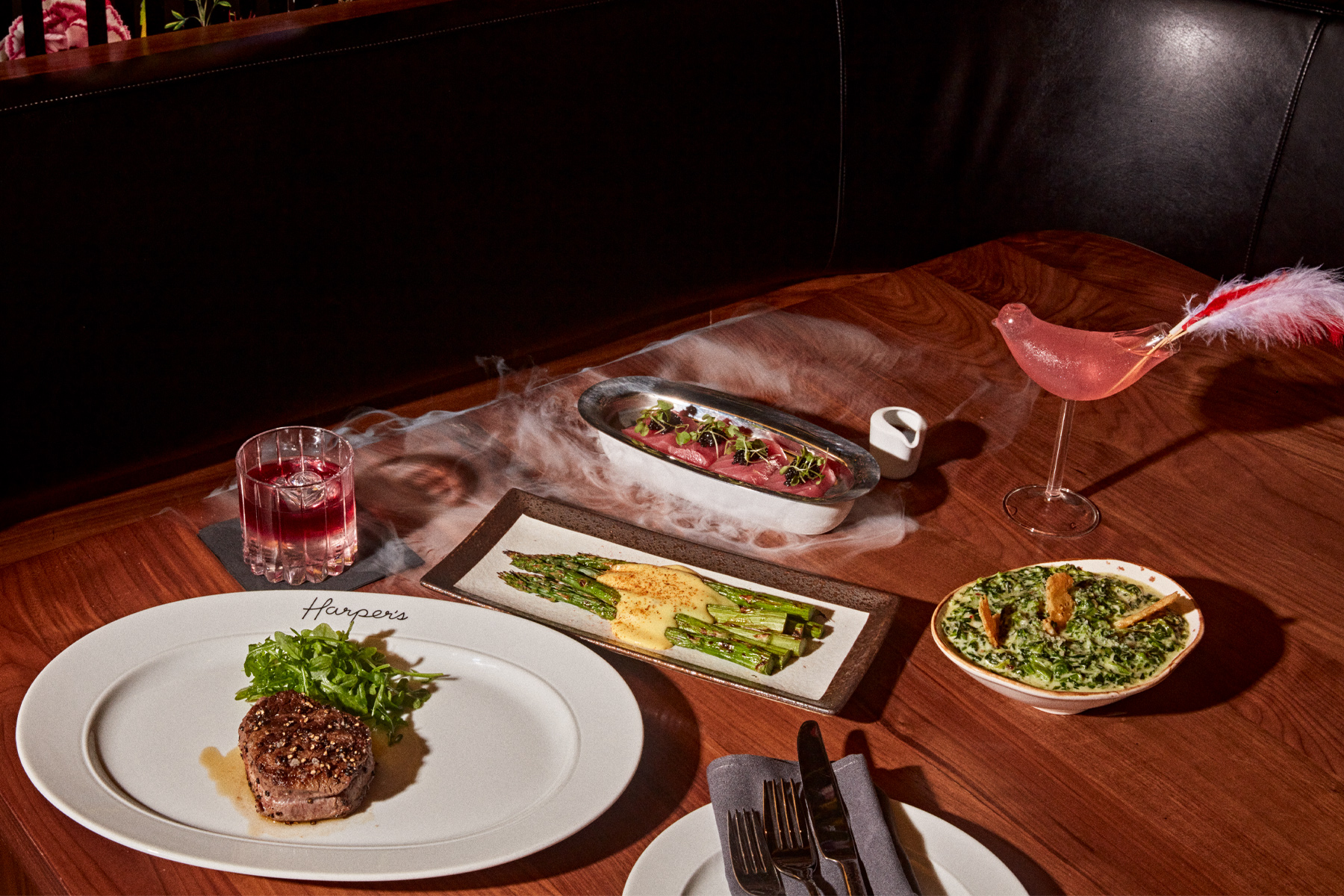
Harper’s fried calamari is mixed with pickled and fried cherry peppers and served with a fiercely garlicky aioli. The calamari itself is cut thick, so you can strongly taste the squid and the sea. If the batter wasn’t so soft and prone to sog, they’d be the city’s best.
Every time I visited neighbors Komodo and La Neta, I took a look into Harper’s again. Every time, I could easily count all the customers in the place, usually about a dozen. The steakhouse’s scattershot (if competent) menu, flashy decor, and eerie calm are a warning to its sibling restaurants. When the hype fades, what remains? Harper’s and La Neta, especially, feel generic, with no sense of place or seasonality. They rely on novelty—wallpaper, lobster tacos, flaming drinks, bathroom liquor displays—and once we’ve seen the gimmick, we’ll move on, the same way we would if we saw how a magician does the trick.
You’d feel a lot better about eating at Harper’s if it were inside a Marriott in Arlington, not one of the state’s most vibrant dining neighborhoods. Deep Ellum is full of fun, quirky restaurants with memory-making food and drinks. Some of them are even party scenes, like Ruins and Revolver Gastro Cantina. I felt like running through this accursed alley telling everyone to go feel alive at Niwa Japanese BBQ.
But I worry that The Epic stands as a mission statement for developer Westdale’s monetization of the historic neighborhood. The firm owns many properties here, including the music venue formerly known as The Bomb Factory. (Westdale dropped “Bomb” from its name.)
Deep Ellum offers other dimensions, such as its sense of history and fiercely independent spirit, that don’t fit so neatly into a luxury developer’s business plan. The Epic, I fear, presents Westdale’s vision of Deep Ellum’s future as a money extraction device. At the end of the night, the customer has less money, the landlord has more, and the content of the experience doesn’t much matter.
The Epic could be in any city where people think money can buy happiness. All of its details—gloopy sauces, pre-batched drinks, TV slideshows, surprise fees, diarrhea warnings—are designed to be shared and forgotten, to vanish down a social media feed. Judging from the quiet at Harper’s, the forgetting has already begun.
This story originally appeared in the August issue of D Magazine with the headline, “There Goes the Neighborhood.” Write to [email protected].
Author



